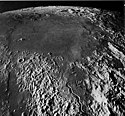Mare Vaporum






Mare Vaporum (česky Moře par) je malé měsíční moře přibližně okrouhlého tvaru s průměrem kolem 245 km a rozlohou cca 55 000 km²[1] rozkládající se na přivrácené straně Měsíce, severně od Sinus Medii (Záliv středu) a východně od Sinus Aestuum (Záliv veder). Ze severu je obklopeno pohořími, na severozápadě Montes Apenninus (Apeniny) a severovýchodně Montes Haemus. Na východě vyniká kráter Manilius s terasovitými valy a středovým pohořím. Na jihu se táhne mělká brázda Rima Hyginus (délka přibližně 220 km).[2]
Pojmenování
Mare Vaporum pojmenoval (stejně jako většinu ostatních měsíčních moří) italský astronom Giovanni Battista Riccioli, jehož nomenklatura z roku 1651 se stala standardem.[3][1][4]
Odkazy
Reference
V tomto článku byl použit překlad textu z článku Mare Vaporum na anglické Wikipedii.
- ↑ a b RÜKL, Antonín. Atlas Měsíce. Praha: Aventinum, 1991. ISBN 80-85277-10-7. Kapitola Triesnecker, s. 92/33.
- ↑ Mare Vaporum Archivováno 21. 2. 2013 na Wayback Machine., NASA.gov (anglicky)
- ↑ Ewen A. Whitaker, Mapping and Naming the Moon (Cambridge University Press, 1999), str. 61 (anglicky)
- ↑ Autostar Suite Astronomer Edition. CD-ROM. Meade, April 2006. (anglicky)
Literatura
- RÜKL, Antonín. Atlas Měsíce. Praha: Aventinum, 1991. ISBN 80-85277-10-7.
Související články
Externí odkazy
 Obrázky, zvuky či videa k tématu Mare Vaporum na Wikimedia Commons
Obrázky, zvuky či videa k tématu Mare Vaporum na Wikimedia Commons - Mare Vaporum, Gazetteer of Planetary Nomenclature, IAU, USGS, NASA (anglicky)
- Mare Vaporum Archivováno 21. 2. 2013 na Wayback Machine., NASA.gov (anglicky)
Média použitá na této stránce
Apollo, AS17-1674 (M) (Altitude: 104km): It is common for the circular form of a very old basin to survive even after all basin materials are obliterated. Mare Vaporum, as shown in this south looking oblique photograph, provides a good example. Its average width is about 200 km. Its circular form marks the outer edge of the ancient, deeply buried Vaporum basin. All the terrae surrounding Mare Vaporum are blanketed by massive ejecta of the Imbrium basin, the center of which lies to the north, behind and to the right of the camera. The ejecta disappears beneath Mare Vaporum. The circularity is enhanced at the left (east) of the picture by a system of mare ridges and scarps that was localized over an old Vaporum basin ring. The cratered, linear Hyginus Rille is near the southern horizon, and the sinuous Conon Rille, to be described later in this book, is in the foreground. (Figure 35 in: H. Masursky, G.W. Colton, and F. El-Baz (eds.) (1978). Apollo over the moon: A view from orbit. NASA, Washington DC)
Mare Vaporum, the "Sea of Vapors", is located between the southwest rim of Mare Serenitatis, and the southeast rim of Mare Imbrium. The lunar material surrounding the mare is from the Lower Imbrian epoch, and the mare material is from the Eratosthenian epoch. The mare lies in an old basin or crater that is within the Procellarum basin. The crater Manilius can be seen as the bright circular object to the right of the mare. You can barely make out some of the rays coming off of the crater. To the south is a light colored thin line. This feature is Rima Hyginus. In the upper left side of the photo is the mountain range Montes Apenninus.
Autor: User:Silvercat, Licence: CC BY-SA 3.0
The location of Mare Vaporum, one of the Lunar geographical features.
Crater Triesnecker (detail of LRO - WAC global moon mosaic; Mercator projection)
Autor:
- Peter Freiman
- Cmglee
- Background photograph by Gregory H. Revera
Lunar nearside with major maria and craters labelled.
Autor: M. Gålfalk, G. Olofsson, and H.-G. Florén; SIRCA camera, Licence: CC BY-SA 3.0
Sea of Vapors, on the en:Moon. Infrared image in L band centred on 3.75 micrometres. Taken with the SIRCA camera by M. Gålfalk, G. Olofsson, and H.-G. Florén. Nordic Optical Telescope, Stockholm Observatory. More images can be found here.





